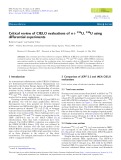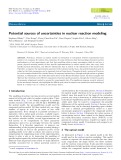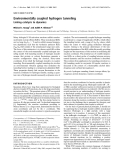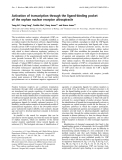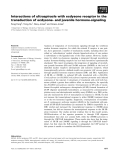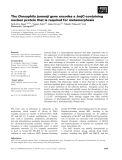
Nuclear reaction modeling
-
Key reactions have been selected to compare JEFF-3.3 (CIELO 2) and IAEA CIELO (CIELO 1) evaluated nuclear data files for neutron induced reactions on 235U and 238U targets. IAEA CIELO evaluation uses reaction models to construct the evaluation prior, but strongly relied on differential data including all reaction cross sections fitted within the IAEA Neutron Standards project.
 5p
5p  christabelhuynh
christabelhuynh
 29-05-2020
29-05-2020
 17
17
 1
1
 Download
Download
-
It is also well known that the knowledge of nuclear reaction mechanisms is at best approximate, and that their modeling relies on many parameters which do not have a precise physical meaning outside of their specific implementations in nuclear model codes: they carry both specific physical information, and effective information that is related to the deficiencies of the model itself.
 8p
8p  christabelhuynh
christabelhuynh
 29-05-2020
29-05-2020
 13
13
 2
2
 Download
Download
-
Many biological C-H activation reactions exhibit nonclassical kinetic isotope effects (KIEs). These nonclassical KIEs are too large (kH/kD 7) and/or exhibit unusual temperature dependence such that the Arrhenius prefactor KIEs (AH/AD) fall outside of the semiclassical range near unity. The focus of this minireview is to discuss such KIEs within the context of the environmentally coupled hydrogen tunneling model.
 9p
9p  system191
system191
 01-06-2013
01-06-2013
 41
41
 4
4
 Download
Download
-
The invertebrate nuclear receptor, ultraspiracle (USP), an ortholog of the vertebrate RXR, is typically modelled as an orphan receptor that functions without a ligand-binding activity. The identification of a ligand that can transcrip-tionally activate USP would provide heuristic leads to the structure of potentially high affinity activating compounds, with which to detect unknown regulatory pathways in which this nuclear receptor participates.
 11p
11p  tumor12
tumor12
 22-04-2013
22-04-2013
 41
41
 2
2
 Download
Download
-
Analyses of integration of two-hormone signaling through the vertebrate nuclear hormone receptors, for which the retinoid X receptor is one part-ner, have generated a number of mechanistic models, including those des-cribed as ‘subordination’ models wherein ligand-activation of one partner is subordinate to the liganded state of the other partner.
 13p
13p  awards
awards
 06-04-2013
06-04-2013
 19
19
 3
3
 Download
Download
-
Jumonji (Jmj) is a transcriptional repressor that plays important roles in the suppression of cell proliferation and development of various tissues in the mouse. To further clarify the roles of Jmj during development and gain insight into mechanisms of Jmj-mediated transcriptional regulation, we have taken advantage ofDrosophilaas a model organism.
 13p
13p  media19
media19
 05-03-2013
05-03-2013
 38
38
 3
3
 Download
Download








